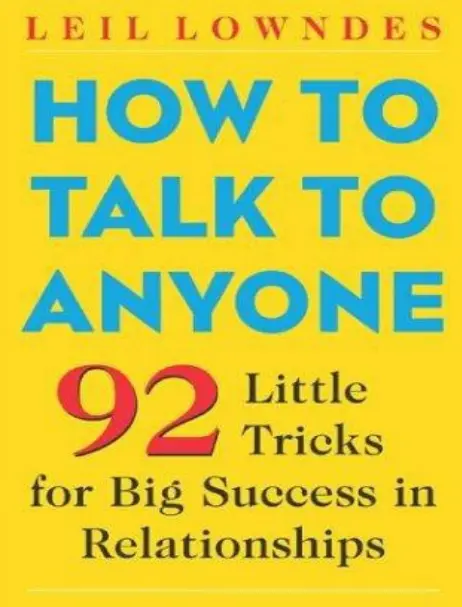
“You’ve heard people say ‘She has a magnetic personality’ or ‘He lights up a room.’ What exactly do these people do? What’s their secret? They simply use their bodies to communicate ‘I think you are wonderful and I’m very, very glad to be with you.’ They stand up straight up with their shoulders back. They lean forward, genuinely interested in what you have to say. They look you right in the eye, and they don’t let their eyes wander while you’re speaking to them. They touch you appropriately.
“How to Talk to Anyone: 92 Little Tricks for Big Success in Relationships” is Leil Lowndes’ practical guide to effective communication skills, published in 1999. Unlike theoretical communication texts, this book delivers exactly what its title promises: 92 specific, actionable techniques for improving interactions in professional and social settings, organized into clear categories and delivered with memorable names and real-world examples.
Lowndes’ approach is distinctively pragmatic – she presents communication not as an abstract art but as a learnable skill set comprised of specific behaviors that anyone can master through deliberate practice. Drawing from her background in theater, psychology, and decades as a communication consultant, she breaks complex social dynamics into digestible techniques that work even for naturally shy or awkward individuals.
The book begins with first impressions, which Lowndes argues are formed within seconds and “can be about 75 percent of another person’s perception of you.” She introduces techniques like “The Flooding Smile” (delaying your smile slightly when meeting someone to appear more authentic), “Sticky Eyes” (maintaining eye contact slightly longer than usual), and “Epoxy Eyes” (keeping eye contact during conversations) – all designed to project confidence and genuine interest.
For verbal communication, Lowndes offers strategies like “Never the Naked ‘Hello'” (always follow greetings with a statement or question) and “The Premack” (learning one fact about someone’s interest before meeting them). She emphasizes what she calls “big baby pivot” – turning fully toward speakers to signal complete attention – and advises against communication killers like interrupting, one-upping stories, or wandering eyes.
The book’s middle sections focus on developing rapport through techniques like “parroting” (repeating key words someone uses), “echoing” (using similar sentence structures), and “empathizers” (small verbal confirmations that you’re listening). Lowndes introduces more advanced skills for handling phone calls, parties, and professional gatherings – including her famous “Be a Copycat” technique, which involves subtly mirroring someone’s body language and speech patterns to establish subconscious connection.
For business settings, Lowndes offers especially valuable advice on projecting authority without alienating others. Her technique “Employ Empathizers” demonstrates how small verbal signals (“I see,” “How interesting,” “Mmm-hmm”) dramatically improve others’ perception of you as a listener, while “The Killer Compliment” teaches delivering specific, research-based praise to colleagues and superiors.
Throughout, Lowndes balances tactical advice with psychological insights, explaining not just how but why these techniques work based on human social wiring. She acknowledges that some readers might initially find these methods calculating, but argues that “good communication skills are nothing more than techniques for packaging your thoughts and emotions into a form that makes others feel comfortable with you” – ultimately creating more authentic connections.
What distinguishes this book from other communication guides is its remarkably specific, technique-based approach. Rather than offering general advice to “be confident” or “show interest,” Lowndes provides explicit behavioral prescriptions: maintain eye contact for exactly one additional second; nod precisely three times when someone makes a point; stand at a specific angle when joining group conversations.
The book concludes by addressing how these individual techniques build toward Lowndes’ ultimate goal: developing genuine charisma and connection. While acknowledging that her methods might initially feel mechanical, she assures readers that with practice, these behaviors become natural habits that allow your authentic self to shine through more effectively.